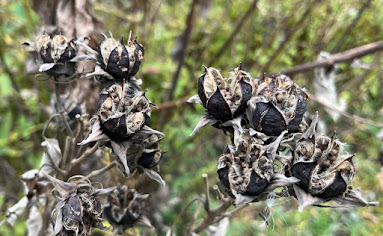There are more official rules out there for seed collection, particularly of uncommon species, but nearly all the seeds I collect now are either from my backyard or the Botanical Art Garden, both of which I planted. It's gratifying to see these new populations of local genotypes thriving, and to expand their local presence further.
The plants I harvest from tend to be generous towards a human tendency to procrastinate. Many species hold on to their seeds for months in the fall and into the winter. But the prettiest time to be picking them is sooner rather than later, as they become increasingly weathered and threadbare as winter progresses.
Rose mallow hibiscus (Hibiscus moscheutos) holds its seeds in convenient cups. Best not to wait too long, because there's a slow attrition to spillage and insects as winter sets in.
Harvest of wild senna, seen in the first photo at a lovely stage when the leaves contrast with the dark seed pods, can be postponed considerably, as the pods hold onto the seeds for months.
The bright, fluffy clusters of ironweed seeds are easy to identify on stems that can reach 8 feet.As with other sedges, the seed clusters of morning star sedge (Carex grayi) will break apart as fall progresses. Some other local sedges with easily collectible seeds are squarrose sedge and fringed sedge.
The seeds of bottlebrush grass, attractively arranged along the stem, were already starting to fall off when I collected them in late October. Just grab the dried stem between thumb and finger and pull upward to strip the seeds. This is an attractive understory grass. The seeds of turtlehead (lower left in the photo) are still ripening, having shown their own form of procrastination, waiting until early fall to bloom.
Collecting seed has extra meaning and purpose this fall, because many of them will be planted along a wooded slope in Herrontown Woods where a large clone of wisteria had pulled down some of the trees, creating openings where sun can reach the ground. Years of effort, particularly with the consistent, transformative work over the past year or two by volunteer Bill Jemas, has largely snuffed out the daunting wisteria clone that had taken over an acre or two, choking other growth as it steadily expanded along this broad hillside. It even somehow traversed the creek and was headed towards the Botanical Art Garden, adding another layer of urgency to knocking it out. Into the void created by our wisteria removal has come garlic mustard and stiltgrass, but this year we pulled those before they went to seed.
With much of the slope now bare (the photo shows wisteria to the right, cleared areas to the left), it's time to introduce native plants. We could toss the seeds hither and yon, but I like to give them a better chance by being more deliberate. Deer are an issue, of course, given their appetite for native plants, and my plan is to plant seeds in small circles here and there, creating loci a couple feet wide. I like to scrape a thin layer of dirt away, scatter some seeds, then sprinkle some dirt on top and tamp it down. Then I'll place a 3 foot high plant cage around each circle. Those that grow inside the cage should be protected enough to mature and produce seed that can then scatter beyond the cage on its own in subsequent years.
It's actually a good way to find out which species the deer leave alone, and which they munch on. We are, in a way, creating "deer feeders" by protecting a few plants inside the cages--plants that each year spread beyond the cages, where the deer can eat them. This approach has been successful at the Barden. Thanks to the town's investment in annual deer culling, many of the plants that sprout beyond the cage survive.
Of course, all of this thus far is talk. Procrastination is a particularly powerful factor when it comes to getting plants or seeds in the ground. There's so much other work to be done! What's real and lovely, and has actually happened, is the seed collecting.







No comments:
Post a Comment